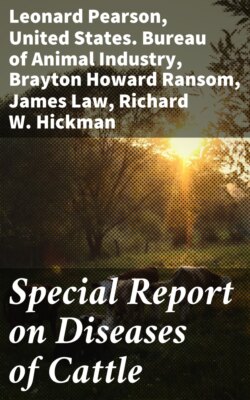Читать книгу Special Report on Diseases of Cattle - Lowe - Страница 25
На сайте Литреса книга снята с продажи.
ОглавлениеTumors form not infrequently in the pharynx, and may give rise to a train of symptoms varying according to their size and location. The tumor may be so situated that by shifting its position a little it may partially obstruct the posterior nares (nostrils), when, of course, it will render nasal breathing very noisy and labored. In another situation its partial displacement may impede the entrance of air into the larynx. In almost any part of the pharynx, but especially near the entrance of the gullet, tumors interfere with the act of swallowing. As they are frequently attached to the wall of the pharynx by a pedicel or stalk, it will be seen that they may readily be displaced in different directions so as to produce the symptoms before described. Enlarged postpharyngeal lymphatic glands are not rare in tuberculosis, and by pressing upon the wall of the pharynx and restricting the lumen of this organ they cause difficulty in both breathing and swallowing. Such enlarged glands may be differentiated from tumors by passing the hand into the cow's throat after the jaws are separated by a suitable speculum or gag.
Treatment.—The method of treatment in such cases is to separate the animal's jaws with an instrument termed a gag, and then, after drawing the tongue partially forward, to pass the hand into the pharynx and to twist the tumor gently from its attachment. One veterinarian who has had considerable practice in treating this form of disease scrapes through the attachment of the tumor gradually with his thumb nail. When the attachment is too strong to be severed in this way an instrument like a thimble, but possessing a sharp edge at the end, may be used to effect the same purpose, or the base of the tumor may be severed by the use of a crushing instrument known as an écraseur.
